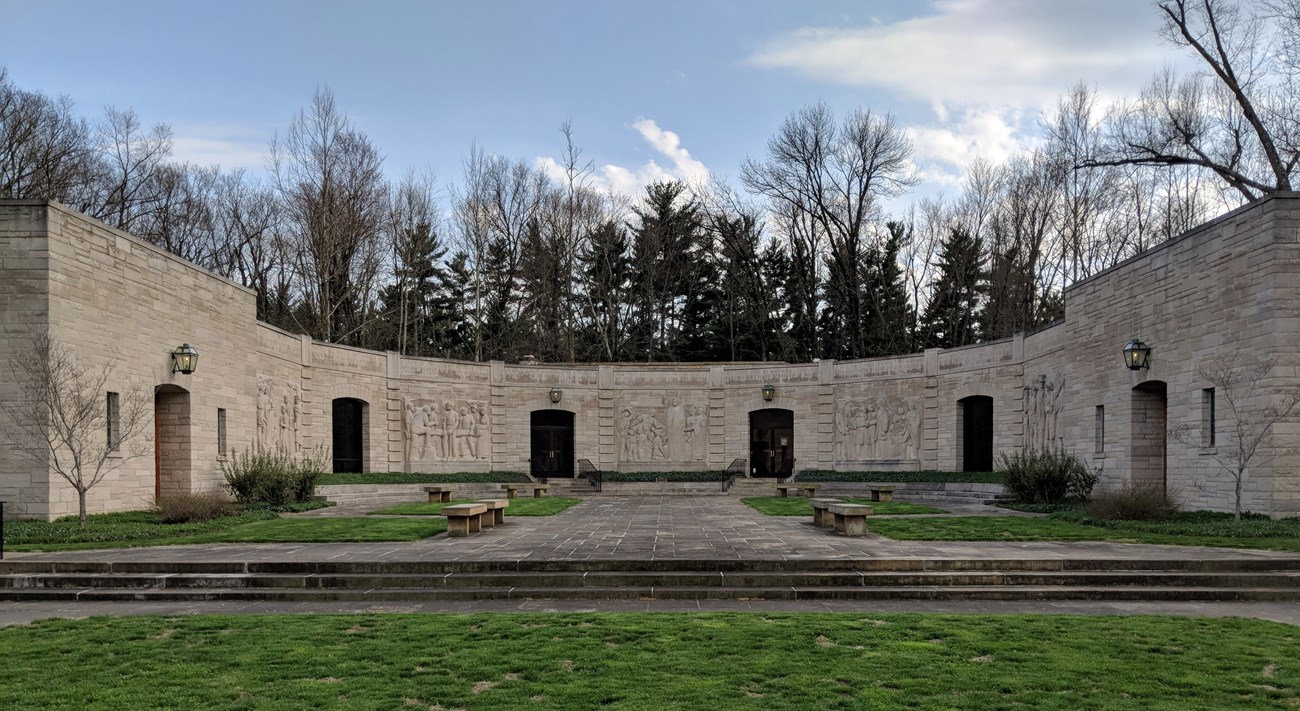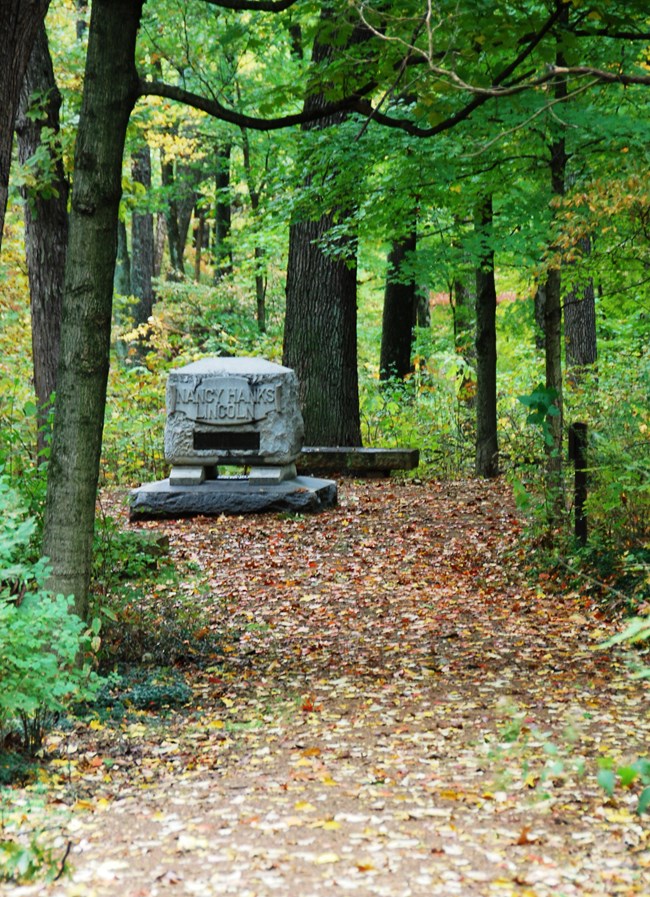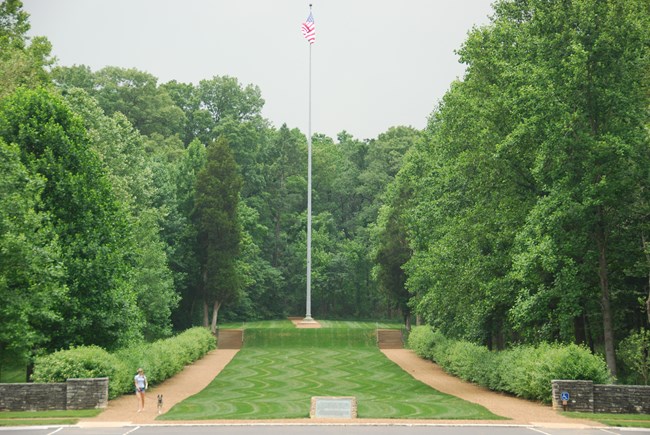Last updated: February 23, 2021
Article
Lincoln Boyhood National Memorial Cultural Landscape

NPS
After President Abraham Lincoln’s assassination in 1865, his supporters sought to commemorate his life and legacy. As with many famous individuals, their early years and influences are looked upon for insight into their character and their lifetime achievements. Visitors and residents of Spencer County, Indiana visited President Lincoln’s boyhood home and undertook improvements to the gravesite of Lincoln’s mother, Nancy Hanks. They recognized that her life and death were important events during Lincoln’s formative years. In the early 1900s, the state legislature created the Lincoln Memorial Commission “to erect a suitable memorial,” and the state acquired the cemetery and a surrounding tract of land.
The period of significance is from 1927 to 1945, beginning with the hiring of the Olmsted Brothers, a renowned landscape architecture firm, by the state of Indiana and ending with the completion of the memorial building site. In 1962, the commemorative portion of the Lincoln State Park was transferred to the NPS with the designation of Lincoln Boyhood National Memorial by President John F. Kennedy. Lincoln Boyhood National Memorial is characterized as a historic designed landscape for the plan and execution of the Frederick Law Olmsted Jr. design and later contributors, Donald Johnston, Edson Nott, and Richard Bishop.

NPS
Landscape Description
The Lincoln Boyhood National Memorial in south central Indiana occupies approximately 200 acres, 100 of which compose the commemorative landscape. As originally intended by landscape architect, Frederick Law Olmsted Jr., the historic designed landscape retains a strong north/south axis that allows for a processional and contemplative experience. The axis relates the pioneer cemetery, containing the gravesite of Nancy Hanks, and visitor center and its adjacent court. The exterior wall of the Memorial Visitor Center displays five sculptured panels that portray significant periods of Lincoln’s life including his boyhood, his political success, and his presidency.From the pioneer cemetery, the Trail of Twelve Stones and the Boyhood Trail informally lead to the Lincoln cabin site and Cabin Site Memorial on the Living Historical Farm. The trail surface, like much of the site, utilize local materials, specifically crushed river rock. The Trail of Twelve Stones includes different stones that represent periods and events of Lincoln’s life, such as his Gettysburg Address of November 19, 1863 on a Pennsylvania Civil War battlefield.
Wooded areas help frame and reinforce the form of the designed landscape. These wooded areas contain mixed hardwood species with many trees planted under the Civilian Conservation Corps and state reforestation efforts from 1930 to 1934.
Historic Use
Abraham Lincoln, born to Thomas and Nancy Hanks Lincoln on February 12, 1809, spent a portion of his childhood in Kentucky until moving with the family to Indiana in December 1816. In Indiana, Abraham’s father claimed 160 acres to start a farm where he constructed a rustic log cabin. The family grew corn, wheat, and oats. In 1818, Nancy Hanks passed away from the mysterious milk sickness and was buried on a wooded knoll near the homestead. In total, Abraham Lincoln spent 14 years on the Indiana farm, from age 7 to 21.
After President Lincoln’s assassination, local residents took wood and stone as mementos from what was believed to be the Lincoln cabin site, destroying evidence of a historic cabin in the process. The dilapidated gravesite of President Lincoln’s mother attracted the attention of community members seeking to commemorate the deceased president and recognize his connection to the area. Indiana governor, James Mount, helped form the Nancy Hanks Lincoln Memorial Association to improve the gravesite’s poor condition. The association was dissolved in 1907 and later replaced by the Indiana Lincoln Memorial Commission in 1923. The State Assembly authorized the commission to create a memorial at the site. Again, the Commission was dissolved and replaced by the Indiana Lincoln Union (ILU) in 1926, which was composed of local and state business leaders and employees responsible for raising funds for a memorial. .

NPS
The ILU elected to hire the Olmsted Brothers, based out of Massachusetts, to create a preliminarily design for the memorial. Fredrick Law Olmsted Jr. took the lead and developed a plan to simplify the area around the gravesite and provide focus to a landscape that had many designs over the years. He established a cruciform arrangement by combining a main allée with a relocated highway bed. This arrangement provided both form and “strong spiritual imagery.” Olmsted also proposed reforesting part of the site to provide a backdrop for the formal design.
Construction commenced in 1929. The ILU hired landscape architect Donald Johnston to refine and execute the Olmsted plan. During this time, workers regraded the topography near the gravesite and began reforestation efforts. Upon the suggestion of the President of the ILU, a variety of stones were installed along the Trail of Twelve Stones to represent locations and historic buildings around the country that were significant in Lincoln’s life. The Olmsted design was completed in 1934. Around this time, the CCC joined the project and added more site amenities.
The second major phase of construction began in 1938, when ILU members identified the need for a building facility. They again consulted Fredrick Law Olmsted, Jr., who proposed a set of buildings at the southern end of the allée. NPS architect Richard Bishop was selected to finalize and implement the design. In the 1960s, the Memorial building was enclosed to create the Memorial Visitor Center.
Today, visitors to Lincoln Boyhood National Memorial can gain insight into President Lincoln’s life through the historic designed landscape. The landscape design was the result of numerous collaborations to honor the President and symbolize his experiences, such as a formal core which represents the solitude and somberness of his mother’s passing during his early years. Surrounding the formal core, the meandering trails reference the wonderment and exploration that were also part of Lincoln’s boyhood days.
Quick Facts
- Cultural Landscape Type: Historic Designed Landscape
- National Register Significance Level: National
- National Register Significance Criteria: B,C
- Period of Significance: 1927-1945
- National Historic Landmark

